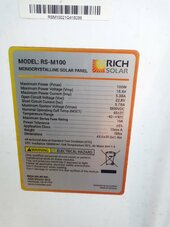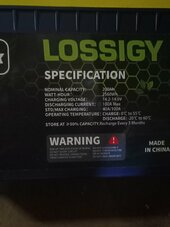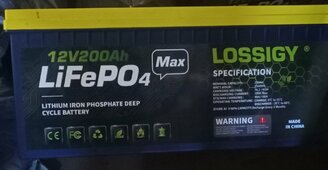OK, let's take stock of what you've got to work with and see what's left:
2x 200Ah 12v batteries - LFP (which is good) but may or may not be damaged. You've basically got 4000wh of available power to work with which is a pretty good supply for the light loads you're working with.
4x 100w panels - Mono panels are good, if small. I'd guess you're probably only going to see 4 hours of decent sun a day ON AVERAGE where you are (winter is gonna SSUUCCKK!!!), so call it 1600Wh of power a day on average. That means it's going to take 3 days of no loads to refill those batteries if you drain them dry.
Battery charger - I'm guessing it's a car charger or is it one that supports LFP on the label? If it's a car charger, set it to maximum amps and the AGM profile, that'll be pretty darned close to what LFP wants. Let them both charge overnight to give them time to fully fill and to balance the cells inside.
So, a couple options here:
Your batteries only have a 100a BMS on them, so if you did a 24v system you'd max out at about 2200w after inefficiencies and such. You can't fully feed a 3000w inverter with that. If you went with 12v you'd be able to pull 200w (because each battery would only be doing half the work) but that still limits you to about 2200w. So either way you're not going to be able to feed a 3Kw inverter UNLESS you get a 3rd battery in parallel on a 12v system, then you could get 3500w. But that's neither here nor there. It seems like the best bet would be a 2500w 24v pure sine inverter. I'd suggest WZRELB or Giandel because they're a good value and you don't have $$Victron$$ money to blow.
The charge controller is going to need to be a 20a at least but that'll max out those panels on a 24v setup with no room to grow. The cost difference between a 20a and a 40a isn't that much at all and would give you some room to add more panels later. Don't go blowing money on $$Victron$$, there are plenty of other brands that will turn solar DC into battery DC just fine. I'm a fan of HQST myself, but Rich Solar, BougeRV, and even PowMr will do the job. Some blue spray paint will impress the folks here.

Avoid EPEver as they've got a known bug that likes to nerf your production by locking onto the first voltage it gets in the morning and never ramping up. Also, if it has USB ports on it, it's a FAKE and will just rip you off. Expect to drop a couple hundred bucks on a good one that's going to be reliable and give you room to grow.
Solar Panels - OK, so 400w isn't really much, but hit up your local Craigslist for used panels off of someone's roof. Out here in the Seattle area the average is $100 for a 250-275w panel. They're large and heavy, but your MPPT controller will be able to convert the higher voltage they put out into battery friendly voltage just fine as long as you don't over volt them. Remember, PVInput voltage is a HARD limit. Hard like granite or diamonds or impressing your future father-in-law.
Inverter - Since you're pretty much starting from scratch, I'd go with something from Giandel or WZRELB as they're both well regarded and MUCH cheaper than $$Victron$$. For certain make sure it's Pure Sine!! You're going to lose about 1-2% or so of the rating to standby power (the power the inverter needs just to exist) so a 3000w inverter might want 30-60w of power all day long just to exist. There's nothing in your list that calls for a low frequency inverter really so don't worry about that. Since you're on a budget you can either save a little now and get a 1000w and get by, or step up to a 2500w and max out your dollar. I'd recommend the larger so you don't have to spend money again later if you can swing it after the SCC and cables and fuses and and and...
You're going to need both an SCC and an inverter to get a system up and running, plus the wires and crimps and such. A shunt would be a REALLY good investment as I didn't see BlueTooth mentioned anywhere on those batteries and you don't want to find out your batteries are dead by the lights going out. Again, don't waste the money on a $$Victron, grab an Aili for about $35 and it'll tell you everything you really need to know.
Having the batteries is the largest hurdle cost wise. You're probably looking at about $600 or so for the rest of the parts to get you up and started. Solar panels will be the next thing you upgrade so you can fill those batteries up faster than you use them. If your battery charger is a regular car charger and NOT something that supports 24v LFP you're going to have to break down and get a proper charger. That's a down side to 24v, you can use a car charger on a 12v system, and you can get 48v Chargeverters from half a dozen places, but 24v is the odd duck here in that to get more than about 10a of charger starts costing RealMoney. You're also going to need a small generator to get you through winter.
OK, with THAT out of the way-
Option B - The Simple Way!
Head over to SignatureSolar and grab a
refurbed Growatt 3Kw 24v AIO for $500. Set the 4 solar panels into a single string and connect to the PVInput terminals, connect the batteries in series to the Batt connections, cut the female head off an extension cord and wire into the AC Input terminals, turn everything on and walk away. The Growatt has a low maximum PVInput voltage compared to everyone else out there, BUT that means it doesn't need 150+v of panels just to start up! It's got the 60a AC input charging from an inverter generator (1800w!) and it's got an 80a SCC for the solar. I've got 2400w of array at my cabin feeding one of those on a 304Ah battery I built and it runs GREAT! If you can swing it, the Aili shunt would be a nice touch, and you'll need a 125a Class-T fuse or DC breaker for the main positive from the battery, but it's going to be about the same cost, give you room to expand in the future, give you your generator charging, AND be MUCH easier to put together.
Just my thoughts anyways.










